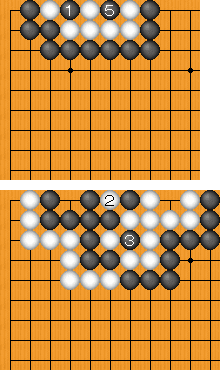There IS such a thing because the players are human and they understand what “confirmation” means. Kakunin 確認, “confirmation”, is in the rules. There is obviously no such thing as “string-by-string, checking capturability without enable for each string” because nothing even close to this statement is written in the rules. If you’re going to talk about the rules, there’s no need to make stuff up. Just read and follow.
So you’re saying that it can be hard for people to understand their own flawed logic? Is that right, huh? Interesting.
Read the rules again. It cannot be the “approach move”, which is a Black stone, that “enables” White to play a new uncapturable stone. It must be a capturable White stone that so-called enables White to play a new uncapturable White stone.
By the way, Example 4 is seki with dame. My position is that Variation A and B have dame. Example 4 does not support your position (hint: none of the examples support your position).
I am not looking at the L&D after. I have no idea how you could come to that conclusion. Actually, I do have an idea of how you could do it, but that’s besides the point. The point is that your use of the term “necessary” is incorrect. The 5 stones do not necessarily have to be captured to “enable” the new uncapturable stone. Because in this position the 5 stones are not captured yet White has placed new uncapturable stones.
Stones are said to be “alive” if they cannot be captured by the opponent, or if capturing them would enable a new stone to be played that the opponent could not capture. Stones which are not alive are said to be "dead.
Because the 5 stones do not even have to be captured for new uncapturable stones to be played, then the 5 stones cannot be said to “enable” the new uncapturable stones. It is the 1 stone that “enables” the the uncapturable stones. Therefore, the capture of the 5 stones adds nothing to the player’s confirmation of L&D status. The 5 stones are dead and so they have dame.



